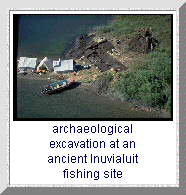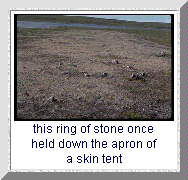


From Ancient Times
... Traditional Inuvialuit Culture
It is clear that traditional Inuvialuit culture shared a number of important traits with its Thule ancestor. Like the Inuvialuit, Thule people enjoyed a relatively elaborate hunting culture, with permanent sod-house winter villages, karigis, and at least the beginnings of social complexity. There are also clear differences. Thule sites are rare or absent even from upland areas unthreatened by coastal subsidence, areas well-endowed with later Inuvialuit sites. It seems reasonable to suppose that the Thule population was significantly smaller than that of the Inuvialuit, and that it was more restricted to coastal margins, where erosion and subsidence have been most active. 
Other important differences include an absence of fish-netting gear in Thule, and an Inuvialuit commitment to the communal kayak-based hunting of beluga whales which transcends anything seen in Thule. The adoption of both seem to have been pivotal in the transition from Thule to Inuvialuit culture, an event which the earliest Inuvialuit radiocarbon dates suggest happened sometime in the late thirteenth century A.D. 
Inuvialuit culture proved remarkably successful and stable, apparently much better adapted to the riverine environments of the western Canadian Arctic than its Thule predecessor. From its origins about seven hundred years ago to the time of European contact five hundred years later, very little in the way of cultural change is apparent in the archaeological record. But changes were just around the corner. 

[Opening Page | The Land | The People | Ancient Times | ...To 1902 | Survival |About the Researcher]